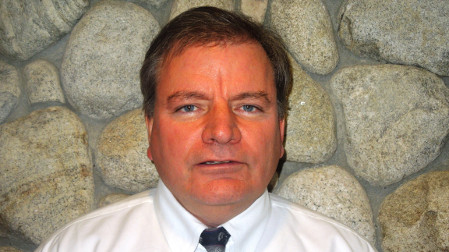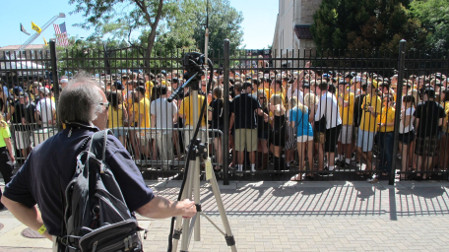Ham TV Operators Go High Definition
ALEXANDRIA, VA.—As described in the initial installment of this article on the movement by radio amateurs or “hams” to digital video transmission, hams have been experimenting with television since the 1920s, and as a group are acutely aware of technological developments in this area, as many are employed in the TV broadcasting, R&D and manufacturing sectors. Through the years, hams have always been quick to try out new technologies including microwave, satellite, digital communications, and most recently, high-definition television.

Mike Collis, WA6SVT
Mike Collis is one of those HD adopters. He’s a California ham (station call sign WA6SVT) who’s been involved in amateur TV since 1976 during his high school days, and recently ventured into high definition. (He’s also transmitter supervisor at a commercial television operation.)
“I moved into high definition about two years ago,” Collis said. “The incentive was the higher clarity pictures.”
Collis is in a fairly unique position in terms of keeping track of the segment of the amateur operators involved in television, as he’s co-publisher of Amateur Television Quarterly, a niche publication dedicated to news of amateur TV experimentation that’s read by more than 400 hams. It was a report of HDTV experimentation by a fellow ham that led Collis to make the shift to high definition.
“I was inspired by Jim Andrews who was doing HD with a Drake 64-QAM cable TV modulator,” Collis said. “I purchased a Drake unit [and went on-the-air with this].”
Collis can’t say for sure how many of his readers are testing the high-definition waters, but is aware of amateur HDTV activity in various parts of the United States, including both northern and southern California, Ohio, Kentucky and Arizona.
The professional video industry's #1 source for news, trends and product and tech information. Sign up below.
One of the most active of these is the aforementioned Jim Andrews (station call sign KH6HTV). He’s a retired electrical engineer and spends his time just about equally in Maui, Hawaii and Boulder, Colo. His experimentation with analog television on the ham bands (amateurs are allocated several chunks of RF spectrum real estate in the UHF and higher frequency bands) also goes back to the 1970s. However, the DTV bug eventually bit, with Andrews making his initial move about five years ago.

Jim Andrews, KH6HTV
FIRST STEPS IN THE REAL OF ZEROS AND ONES TV
“I’d always had an interest in TV,” Andrews said. “And as the whole industry was transitioning to digital [back in the 1990s], I knew that amateurs needed to keep up with what was going on.
His first move was to evaluate the least complicated path to DTV.
“I consider myself an analog engineer with a microwave background and knew there was no way I was going to design my own circuits to do the digital processing. So I became an ‘appliance operator’ [in ham jargon, someone who elects to purchase ready-made equipment, rather than fabricate their own]. I decided to identify available digital [modulation] equipment and then add RF amplification of my own design to get on the air.”
Initially Andrews investigated the commercial ATSC encoding gear that U.S. television stations were installing, but quickly experienced sticker shock.
“All I found was the really expensive stuff made by Harris and others,” Andrews said. “They were all way too expensive. I was really frustrated by the prices; I wanted something down in the $1,000 price range. In 2011, I discovered a digital modulator made by Drake, a company that supplies equipment for cable system head-ends. This was the DFE 24 which sold for about $1,200. It provided 64-QAM and wasn’t intended for over-the-air, but I decided to try it. I soon discovered that QAM didn’t really work well with multipath as it was intended for a really perfect transmission path. There was no correction circuitry to accommodate a poor transmission channel.”
Despite this limitation, Andrews took to the air on the amateur 70 centimeter band (420 to 450 MHz) by adding a 10 Watt RF amplifier of his own design and an antenna that provided an EIRP of about 100 Watts. With this simple system he was ultimately able to achieve a transmission range of some 75 miles (He’s quick to offer that the ham operator on the receiving end of the link was using an antenna with some 27 dB of gain and that the path between the stations was “true line-of-sight”).
Andrews continued to experiment with 64-QAM DTV transmission, but recently discovered encoding gear more suitable for over-the-air applications.
“In the spring of 2014, I saw an article in Amateur TV Quarterly about some U.S. hams using some DVB-T gear made by a Taiwanese company, HiDes,” said Andrews. “They were reporting distances of up to 175 miles. I bought the gear described and ran a lot of field propagation tests which showed that it was far superior to my CATV modulator. This was the way to go!”
With the improved performance of the DVB-T unit, Andrews soon made the step to high definition.
IT’S NOT JUST ABOUT EXPERIMENTATION
So besides propagation and distance experimentation, what else has Andrews done with his DTV transmission capability? As service to the community is one of the tenets upon which amateur radio service was founded, it wasn’t long before he and other Boulder-area hams made their digital capability available to area law enforcement operations.
“We have a really active ARES (Amateur Radio Emergency Service) group in the Boulder,” said Andrews. “We’ve been providing our services to the Sheriff’s Department since 1990, covering public protests, large fires and the like. We’ve also gone out on SWAT calls to provide video coverage to the sheriff’s command center. They don’t have their own coverage capability, and there is no [law enforcement] RF allocation for this either. They turn to the ham radio community for this.” (He noted that several hams were employed in the Sheriff’s Department communications unit.)
“And after I’d gotten into the DVB-T stuff and found out how well it worked, we did a demo for the University of Colorado Police Department in connection with their home games,” said Andrews. “It really outperformed the analog system we’d been using. The police chief was pretty well blown away with the high-definition images. They allocated $10,000 to make a transition to digital HD.”
Andrews explained that the department relies on volunteer assistance from the ham community to staff camera positions and operate the new HD gear. The money went for purchase of additional DVB-T modulators, receivers and RF linear amplifiers, as the hams were able to provide four independent transmission channels for the law enforcement operation. He noted that high-definition coverage had expanded to other University events too.

The Boulder, Colo., ARES group has been providing video linkage for local law enforcement groups for some time. Here a member sends back HD images to assist with crowd control efforts.
“We assisted with a 10K footrace last Spring,” said Andrews. “And most recently we helped with the presidential candidate debate held there.”
He added that the area emergency operations center had been activated for this event, with FBI and Secret Service agents involved.
“We heard that the commanders in the ops center were glued to the pictures provided by our group as they were far superior to the images being generated by the FBI team. This was a real pat on the back for us!”
A GROWING AMATEUR HDTV COMMUNITY
Andrews says that it’s now fairly easy to get on the air with HDTV, with a complete equipment package running in the neighborhood of $1,000.
“That’s exclusive of cameras, but HD camcorders are dirt cheap now,” he said. “Modulators are down in the $300 range and an RF amplifier with a 50 dB gain and 3 W output runs about $375. You can get a suitable antenna for between $50 and $100. A receiver can be purchased for about $150, but a lot of people are using $10 DVB-T ‘dongles,’ basically software-defined radios which do the decoding and spit the data out to a computer.”
This price point has made HDTV readily accessible to the ham community, with the number of HD-enabled operators continuing to increase.
“In the Boulder area we now have at least a dozen hams that are very active,” said Andrews. “All use DVB-T. The real ‘hotbed of amateur TV’ is in southern California. They have actually created a network of repeaters on mountain tops that extends into Nevada and Arizona.”
HAM DIGITAL STANDARDS
Andrews noted that the push to DTV via the DVB standard in amateur radio circles was originally centered in western Europe and in Australia, explaining that the DVB-S (satellite) standard was favored due to the availability of inexpensive DTV satellite receivers. According to Andrews there’s no clear consensus as to whether DVB-S or DVB-T is best suited for amateur work; both systems continue to be used.
He noted that his introduction to DVB-T was essentially painless with the HiDes gear purchased.
“No mods were necessary at all. I used it right out of the box,” he said. “It’s frequency synthesized to address a really broad market. It’s also not channelized—not on standard channels. Channelization is programmable via a USB computer connection.
“You can set the bandwidth from 2 to 8 MHz, he said, noting that the company had responded to ham requests to provide the 2 MHz (and narrower) options. “You can’t do HD at this bandwidth though. It actually supports operation down into the hundreds of kilohertz.”

The ARES group stays busy in volunteering their services to campus police at the University of Colorado. Members are seen here checking out one of the antennas installed on a University building.
When asked about trying out ATSC DTV, Andrews stated that he had finally discovered a modulator selling for less than $1,000.
“I probably would have gone this way if it had been available when I started,” he said. “However, in the meantime, I have a lot of information about the superiority of DVB.”
So what about the movement to 4K and the developing ATSC 3.0 digital standard?
Andrews says that some of the Boulder area hams have expressed interest in UHD and have already purchased 4K receivers.
“I’m sure that the amateur TV community will move in that direction. However, I think cost will be the limiting factor. $1,000 is probably the ‘magic’ threshold for most ham budgets. They will not start experimenting with 4K until the price of modulators drops to the vicinity of $1,000, and as for ATSC 3.0, I haven’t really been keeping up with the developments.”
James O'Neal is the technical advisor to TV Technology.
